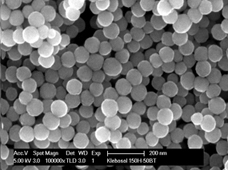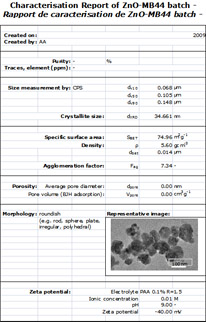| In the project entitled NANOMETRO financed through the European COST-Action 539 (Swiss COST Office), the objective was to develop a reliable database of protocols for measurement and comparison between different methods, instruments, and research groups. These standard methods are essential for novel property exploitation, for the research and development stage of Nanotechnoly as well as to assess the toxicological effects of nanosized powders.
The most important parameter for the production of nanograined ceramics is the particle size distribution (PSD) and state of agglomeration. Agglomeration even when just a few % of the total distribution can have a huge influence on particle packing, sintering and resulting microstructure, grain size and properties. Nanoparticle characterisation protocols allow synthesis routes to be evaluated and optimised, forming and sintering of optimised powders will lead to the highest quality ceramics with nanosized microstructures and possibly new properties. The protocols also help evaluate the health and safety aspects, as the powders are well defined characterised products. |
 |
Website: COST
These protocols have been tested using three “reference powders”: nanosized silica, alumina, and barium titanate from commercial sources. They have also been used for a first series of powders produced in the COST Action 539 (TiO2, BaTiO3, hydroxyapatite Ca10(PO4)6(OH)2, and LiNO3). Comparative measurements between partner laboratories showed that a systematic approach was necessary to be able to compare between synthesis methods and material performances.
These protocols are written for specific instruments. However most of the information, such as the analysis conditions, the sample preparation information… is useful whatever the equipment used. They can be freely downloaded from the bottom of this page.
It is strongly recommended to everyone interested in powder characterization to use these protocols, and give one’s feedback/amendments/recommendation, in order to be able to make Nanotechnology a mature technology within scientific collaborations at an international level.
Contact: Paul Bowen
List of Protocols:
| Specific Surface Area (SSA), by nitrogen adsorption (BET method) | English | French |
| Particle size distribution by X-Ray disc centrifugation (XDC) | English | French |
| Particle size distribution by photon correlation spectroscopy (PCS) | English | |
| Particle size distribution by sedimentation method (CPS) | English | French |
| Particle size distribution by laser diffraction (LD-Malvern) | English | French |
| Mean crystallite size by X-ray powder diffraction line broadening (XRD) | English | French |
| Thermogravimetric analysis (TGA) | English | French |
| Density measurements by helium pycnometry | English | French |
| Zeta potential measurements by electrophoresis method (ZetaPals) | English | |
| Zeta potential measurements by acoustophoresis method (Acoustosizer) | English | French |
| Porosimetry by nitrogen adsorption/desorption isotherms (ASAP) | English | French |
Powderfiles
Data treatments have been normalised to be able to compare between all the different experiments available at LTP. Some “Summary sheets” allow to get a rapid overview of the characteristics of one material. The following Excel sheets have been developed at LTP and are specific to the equipments used there, and described in the above protocols. They can be freely downloaded here.

Publication
Aimable, P. Bowen, “Ceramic Nanopowder Metrology and Nanoparticle size measurement – towards the development and testing of protocols” J. Processing and Application of Ceramics, 4[3] 147-156 (2010)